Scientific name: Amaranthus cruentus ‘Hopi Red Dye’
Common names: ‘Hopi Red Dye’ amaranth, amaranto komo, blood amaranth, purple amaranth, caterpillar amaranth
Family name: Amaranthaceae
Life form: Annual plant
Occurrence in New Mexico: Cultivar
Seed Production: 110 days after planting
Water conditions: Drought tolerant but grows best with regular watering in medium elevations from 2 000 – 10 000 feet
Sun: Full sun, thrives in hot locations
Growing Conditions: Well drained acidic, neutral, or alkaline sandy loamy or clay soils
By Eva Maria Räpple
Waving its clusters of long drooping burgundy-colored flowers, the Amaranthus cruentus or ‘Hopi Red Dye’ amaranth captivates attention in late summer and fall. It is a graceful ornamental plant that can get up to 6 feet tall. It grows well intercropped with peppers, maize, beans, squash, or quinoa.[1] The young leaves can be used as a vegetable, and the seeds consumed as pseudo-grains, processed into flakes, popped, or ground into flour. The ‘Hopi Red Dye’ is a grain cultivar in the large family of amaranths (Amaranthaceae). Between 70 – 80 species are generally subsumed under the taxonomy of amaranths, plants that can grow in a wide variety of marginal soils and conditions from arid high mountain areas to tropical forests throughout the world. The so-called grain amaranths (A. caudatus, A. cruentus, A. hypochondricus) as well as leafy or vegetable amaranths (e.g. A. tricolor) have come to the attention of scientists as adaptive and climate resilient crops which hold great promise for changing environmental conditions.[2] The Santa Fe Botanical Garden has grown ‘Hopi Red Dye’ amaranth in our agricultural terraces for several years, and by late summer when it gains its full 5-foot height with its large purple leaves and extraordinary red flowers, it is the most commented-upon plant in the terraces.
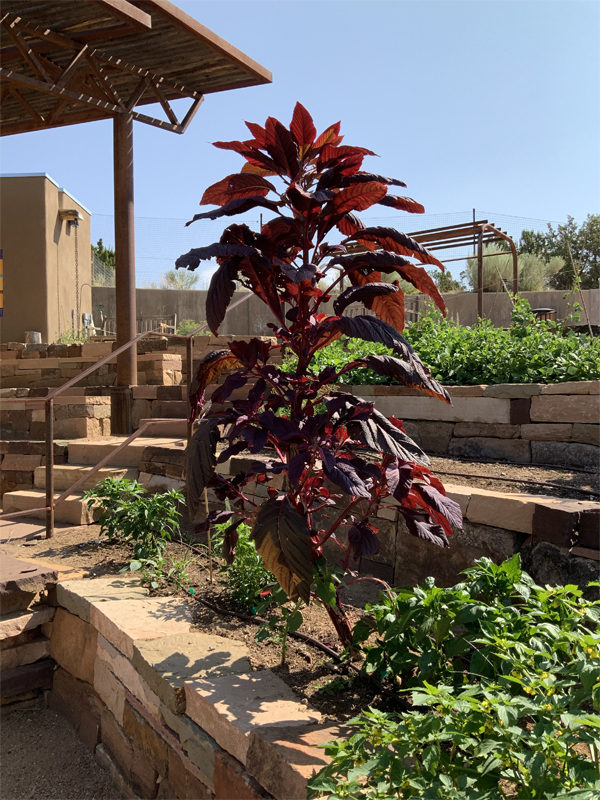
Amaranthus cruentus ‘Hopi Red Dye’ in terraces
Amaranthus cruentus was likely first cultivated in Central America, and has a long history of distribution in particular in the Andean regions (e.g. Peru, Argentina, Bolivia, Ecuador).[3] Seeds found in Puebla, Mexico date back nearly 6000 years. Amaranths cultigens differ from wild species mostly by having a greater number of flowers and seeds that produce a very high grain yield.[4] For Incas, Mayans, and Aztecs, amaranths, both leafy and grain varieties, provided an important food source.[5] Yet it was the ceremonial use – amaranth flour was traditionally used to make small breads and large effigies for religious ceremonies – that appeared blasphemous to the Spanish missionaries and ultimately led to the demise of this “Incan Wheat” as it was called.[6] The suppression of the ceremonial use of grain amaranths after the conquest ultimately led to a drastic decline in the cultivation of this important food source in many Central and South American regions.[7]
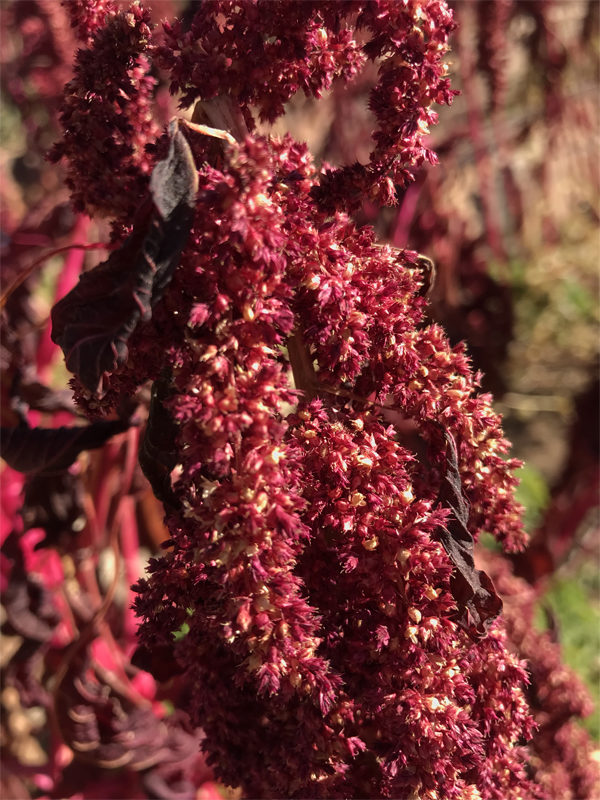
Seed heads up close.
With the enormous amounts of seeds produced by amaranths, it does not come as a surprise that many species are considered pesky weeds which can be invasive in crop fields, limiting the harvest and carrying pests such as the European corn borer and others. Green fields of wild amaranths or pigweeds readily populate disturbed areas and cultivated soils. One redroot pigweed (A. retroflexus) plant can spread between 10,000 and 30,000 seeds. The seeds can survive in soils up to 40 years, waiting for rain. Yet most amaranths, for example the weedy species prostrate pigweed (A. blitoides), are also edible plants. The young leaves as well as growing tips on older plants are very tender, taste like spinach, and are nutrient rich. Indigenous practices likely encouraged wild amaranth volunteers to settle in or around the edges of their garden structures, using their edible leaves and seeds as food sources.[8] The colorful red flowers of the A. cruentus can still be found growing in small quantities along maize fields in rural Mexico. It is the common ornamental garden plant among amaranths in Central America.[9] The colorful A. cruentus also plays a role as a dye plant giving red color to chicha (fermented or non-fermented Latin American beverage). Some Pueblo people of the Southwestern United States still use the amaranth pigment to color maize dough.[10]
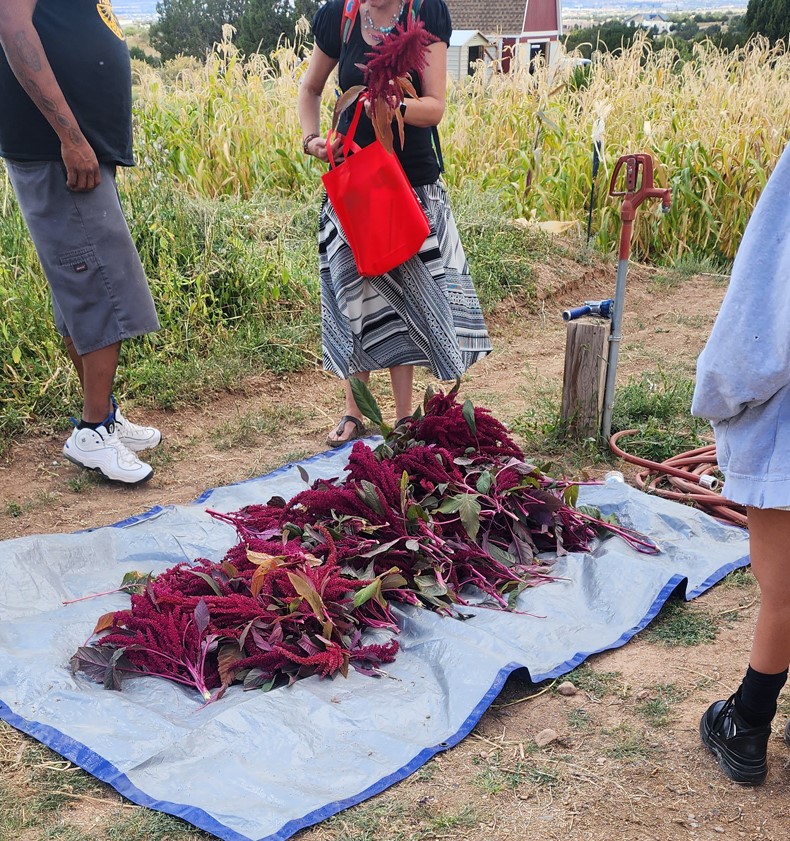
Harvesting amaranth seeds at Institute of American Indian Arts (IAIA). Photo by Christie Collins.
Amaranths are being studied as an underutilized crop with important health benefits, a pseudo-grain that is extremely adaptable and easily grown in degraded, nutrient poor soil.[11] The plant is praised as a “superfood,” a future smart crop for climate resilient agriculture, a rich source of bioactive components with high protein content and health benefits.[12] Aptly, the Greek word amarantos, from which the genus received its name by Linnaeus, means “unfading,” characterizing its robust qualities, and, according to an Aesop fable, immortality and renewed youth.
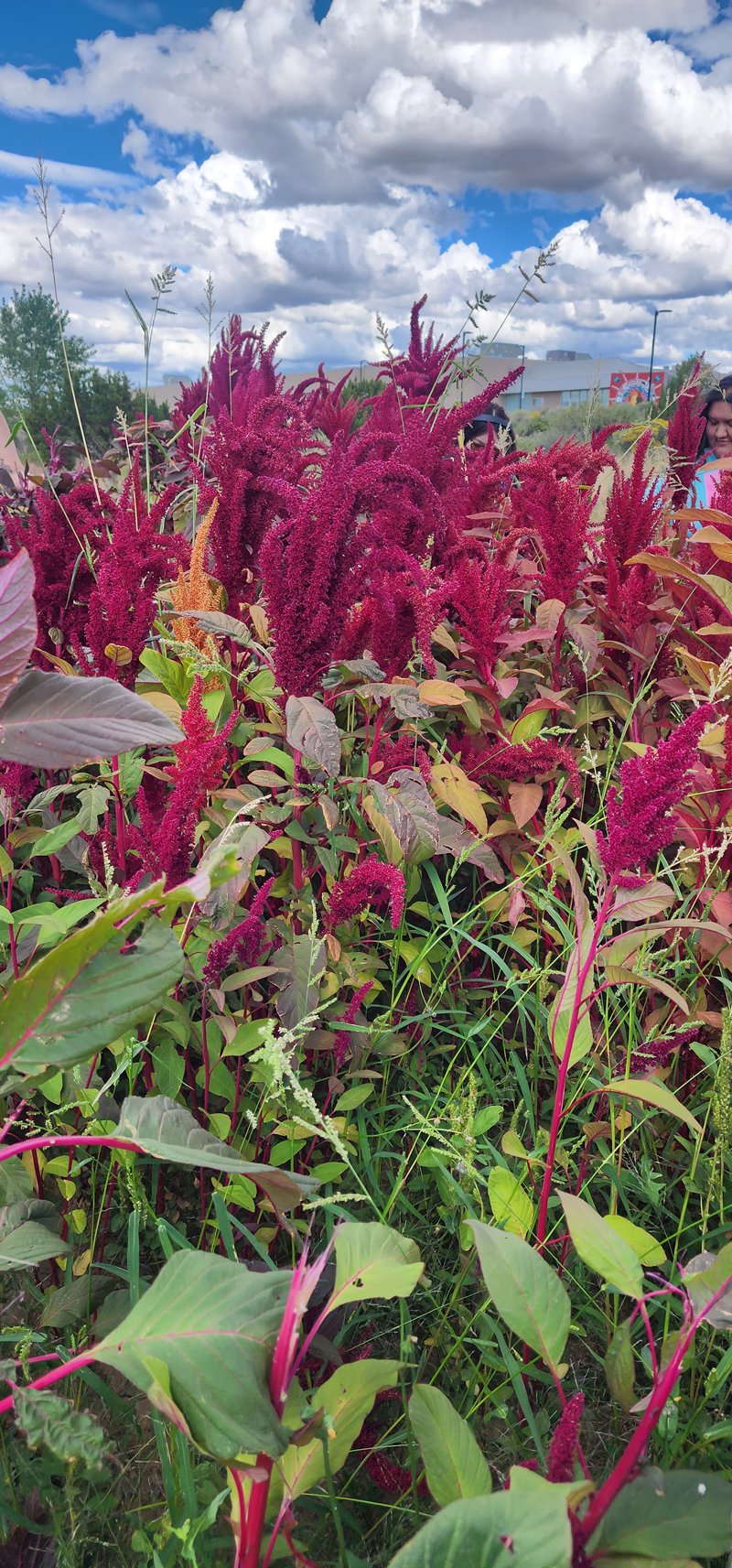
Plants with flowers at Institute of American Indian Arts. Photo by Christie Collins.
THE ROSE AND THE AMARANTH.
An Amaranth planted in a garden near a Rose-tree thus addressed it: “What a lovely flower is the Rose, a favourite alike with Gods and with men. I envy you your beauty and your perfume.” The Rose replied, “I indeed, dear Amaranth, flourish but for a brief season! If no cruel hand pluck me from my stem, yet I must perish by an early doom. But thou art immortal, and dost never fade, but bloomest for ever in renewed youth.”[13]
References
[1] Saubhik Das. Amaranthus: A Promising Crop of Future (Singapore: Springer, 2016), 160.
[2] Ajeet Singh et al. “Domesticating the Undomesticated for Global Nutritional Food Security,” Agronomy 9 (2019): 1-19.
[3] Das, 20.
[4] Jonathan Sauer, “Grain Amaranths and Their Relatives: A Revised Taxonomic and Geographic Survey,” Annals of the Missouri Botanical Garden 54 (1967): 103-137.
[5] Das, 7.
[6] Das, 15.
[7] Sauer (1967) 115.
[8] William W. Dunmire and Gail D. Tiery. Wild Plants of the Pueblo Province. (Santa Fe: Museum of New Mexico Press, 1995), 29.
[9] Sauer (1967) 123-124.
[10] Jonathan D. Sauer, “Amaranths as Dye Plants among the Pueblo People” 6 (1950) 412.
[11] Singh, 1.
[12] Andreea Stânilâ et el. “Phytochemical Composition and Antioxidant Activity of Various Grain Amaranth Cultivars,” Not Bot Horti. Agrobo 47 (2019): 1153
[13] Aesop’s Fables. Trans. Flyer Townsend. (London: George Routledge and Sons, 1878) 174. https://en.wikisource.org/wiki/Three_Hundred_Æsop%27s_Fables/The_Rose_and_the_Amaranth (accessed: Feb.3, 2023)
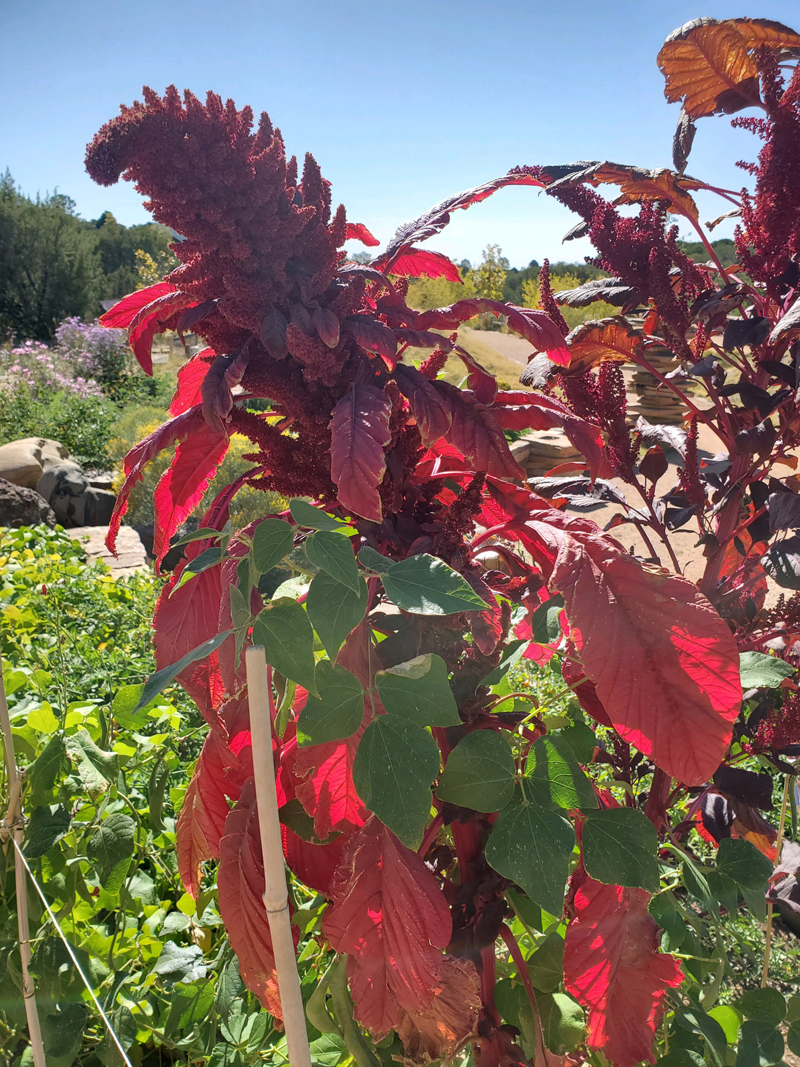
Amaranthus cruentus ‘Hopi Red Dye’. Photo by Joy Mandelbaum.


